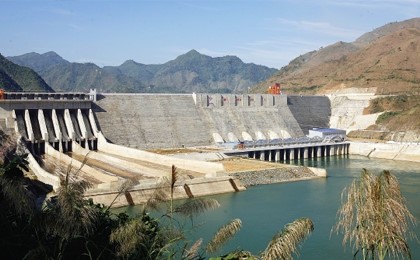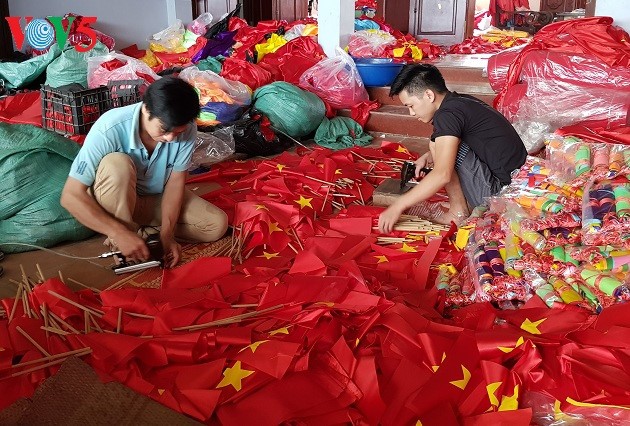A: This week, we received a letter and several emails from Richard Nowak, one of our long time listeners in the US.
B: In his mails, Mr. Nowak expressed his interest in the Letter Box and the Sunday Show. After listening to our broadcast on October 15, he wrote: ‘The Sunday show was great with a photographer who uses his photos to tell stories about Vietnam. He captures Vietnam’s landscape and culture and won a Smithsonian award. He travels far and wide to take the perfect photo. The 15th Annual Smithsonian Contest has drawn more than 50,000 views for his winning photo. He was featured in National Geographic. A photo called “Go fishing” was mentioned. Photography is one of my interests and I found the Sunday Show very enjoyable.”
A: Thank you, Mr. Nowak, for your regular reports on VOV broadcasts as well as for the many cards you’ve sent us. We hope to receive more feedback from you. This week, we received several emails from Mr. Muhammad Shamim of India. In one of them, he asked about the largest hydro electric power project in Vietnam.
 Son La hydro power plant Son La hydro power plant |
B: The Son La Hydro-power Plant in Vietnam’s northwestern region is the largest in Southeast Asia. The plant was put into operation in December, 2012, after seven years of construction, three years ahead of schedule. The Plant, dubbed “the project of the century”, is on the Da river in Son La province.
A: Built for approximately 2.9 billion USD, the Son La Hydropower Plant has six generators with a designed capacity of 2,400 MW. It will supply an average of 10 billion kWh/year to the national grid.
B: The plant will also supply water to the Northern Delta, boosting socio-economic development in the northwest region.
A: The Son La Hydro-power Plant project was built using the state-of-the-art technologies. According to Thai Phung Ne, Deputy Director of the national steering committee for the Son La Hydro-power project all steps from technical design, and project management to execution, supervision, and production of construction components were carried out by Vietnamese enterprises.
B: This is the first time Vietnam has been a key consultant on such a large project in terms of design, construction, and equipment assembly. In the past, such project required about 35,000 workers. This time fewer than 10,000 workers were used.
A: More than 20,000 households in Son La, Lai Chau, and Dien Bien province relocated voluntarily to free up land for the plant.
B: In their emails and letters to VOV, several listeners have asked about the history of the national flag of Vietnam.
 Vietnam celebrates National Day on September 2 Vietnam celebrates National Day on September 2 |
A: The flag of Vietnam first appeared during the southern in 1940 against French rule. A series of articles by writer Sơn Tùng on the origin of the flag were published in state media in 1981. Sơn Tùng said the flag was designed by Nguyễn Hữu Tiến, a leader of the uprising who was arrested by the French and executed in 1941. Tiến, who was born in the northern region was unknown to the Vietnamese public before Tùng's research was published.
B: According to a poem Tiến wrote, the red background represents blood and the yellow foreground represents "the color of our race’s skin". The five points of the star represent intellectuals, peasants, workers, merchants, and soldiers.
A: The flag was used by the Viet Minh or Vietnamese Communist soldiers in the fight against Japanese occupation. At the end of World War II, President Ho Chi Minh declared Vietnam’s independence and signed a decree in 1945 adopting the flag as the flag of the north of Vietnam. The flag was modified in 1955 to make the edges of the star sharper. The red flag with a yellow star of North Vietnam was later adopted as the flag of unified Vietnam in 1976.
 Tu Van village in Hanoi’s outlying district of Thuong Tin is famous for making national flags Tu Van village in Hanoi’s outlying district of Thuong Tin is famous for making national flags |
B: According to the 1992 constitution, the National Flag of the Socialist Republic of Vietnam is rectangular in shape, its height is equal to two thirds of its length, in the middle of fresh red background is a bright five-pointed yellow star".
B: This week, Siddharth Bhattacharjee of India asked about musical instruments in Vietnam.
A: Well, it would take hours to cover all of Vietnam’s musical instruments because we have 54 ethnic groups, each with their own instruments. Vietnam has a rich treasury of musical instruments. Bamboo instruments are among the oldest.
 T'rung musical instrument of Vietnam's Central Highlands T'rung musical instrument of Vietnam's Central Highlands |
B: Bamboo, a familiar symbol of Vietnam has long been used to create musical instruments. Simple bamboo instruments are often played at family and communal events and festivals. According to Emeritus Artist Nguyen Thi Hoa Dang of the Vietnam National Academy of Music, Vietnam’s soil and climate conditions are favorable for growing bamboo whose physical structure lends itself to making musical instruments. Chinese or Philippine bamboo which is thicker and has more closely spaced knots, produces lower, more opaque sounds. Vietnamese bamboo instruments produce purer, more echoing sounds. Its bamboo musical instruments are a source of Vietnamese pride.
A: There are 3 kinds of bamboo instruments: wind, string, and percussion. Flutes and pan-pipes are made of bamboo trunks. Bamboo leaves can also be used to create sound. Bells, drumsticks, and castanets are made of bamboo roots. The T’rung, Dinh Tut, and Ko Ni percussion instruments of the Central Highlanders and the two-string fiddle and 16-string zither are also made of bamboo.
B: Vietnam’s bamboo musical instruments are popular, simple, and distinctive. Almost every ethnic group in Vietnam, including the Kinh, Hmong, Thai, Tay, Nung, Giarai, and Ede, possesses bamboo instruments. The best known Vietnamese bamboo instruments are the T’rung and the monochord, which are played and loved in many other countries. Lesser-known instruments are the Krong Put, Dinh Pa, and Ko Ni of the Central Highlands. All Vietnamese bamboo musical instruments are handmade.
A: Bamboo instruments are played at performances of Vietnamese traditional music, including Xoan singing, Ca Tru ceremonial singing, Quan Ho love duet singing, Hue Royal Court music, and amateur singing, which have all been recognized by UNESCO as intangible heritages of humanity.
A: On today’s program, we’d like to acknowledge letters and emails from Hayato Furukawa of Japan, Grant Skinner of the UK, Siddhartha Bhattacharjee of India, Dilipkumar Sarkar, Muskan Kumari, and Shyamal Kumar Banerjee of India, Mr. Murdock of the US, Andrew Kuznetsov of Latvia, and Fachri of Indonesia.
B: Thank you all for tuning in to VOV. We welcome your feedback at: English Service, VOVWORLD, the Voice of Vietnam, 45 Ba Trieu Street, Hanoi, Vietnam. Or you can email us at: englishsection@vov.org.vn. You’re invited to visit us online at vovworld.vn, where you can hear both live and recorded programs. Check out our VOV Media App available on both the IOS and Android platform to hear our live broadcasts. We look forward to your feedback on the mobile version of vovworld.vn. Once again, thank you all for listening. Goodbye until next time.